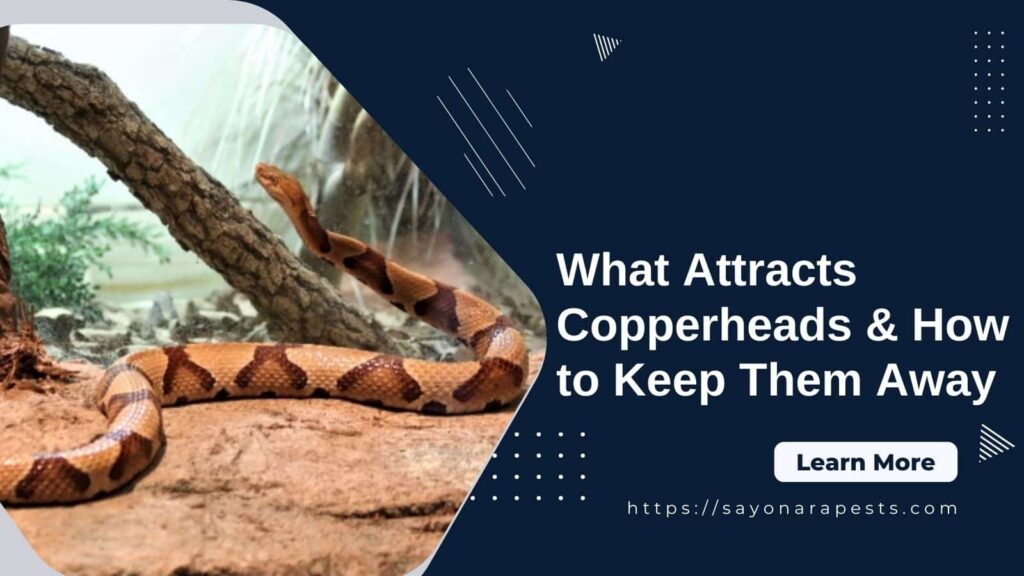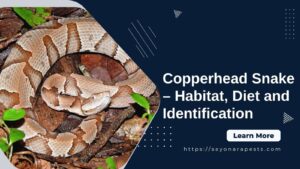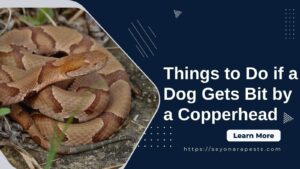People and animals spend more time outdoors as the weather gets warmer. One downside is that it also increases the risk of run-ins with snakes.
Of the many different species of snakes that call North America home, copperheads are among the most commonly seen.
Copperheads are a type of venomous snake that is native to North America.
These snakes are usually between two and three feet long and can be identified by their pale brown or tan color, irregularities with darker crossbands.
While copperheads are not typically aggressive, they will bite if threatened.
If you live in an area where copperheads are prevalent, you must know what attracts them and how to keep them away from your home.
Keep reading to find out.
Several things attract copperheads.
Temperature
Copperheads, which are venomous snakes found in North America, are known to be active during the day and night but are more active during the warmer months of the year.
It is believed that the activity level of copperheads is directly related to the temperature, but whether they are attracted to certain temperatures is unclear.
Some researchers have suggested that copperheads may be attracted to warmer temperatures because they are ectothermic or cold-blooded, which means they rely on the environment to regulate their body temperature.
Copperheads may be more active in warmer temperatures because their metabolism and digestion processes are more efficient at higher temperatures.
However, other researchers have suggested that copperheads may prefer cooler temperatures because they can become overheated and dehydrated in hot temperatures.
One study by the University of Georgia found that copperheads in the southeastern United States were more active during the spring and fall when temperatures were more relaxed.
Still, they were less active during the summer when temperatures were warmer. This suggests that copperheads may prefer cooler temperatures, but the study did not examine whether the snakes were actively seeking out cooler temperatures or simply avoiding warmer temperatures.
Prey
Another thing that attracts copperheads is prey.
These snakes are opportunistic hunters, meaning they’ll eat just about anything they can catch—including rodents, lizards, frogs, and insects.
If an area has a high population of these creatures, likely, there will also be copperhead snakes present.
Shelter
Copperheads are attracted to places where they can find shelter.
This could be in the form of a pile of leaves or under a piece of timber.
Copperheads typically reside in yards with debris or overgrown vegetation in residential areas.
For example, a barn with plenty of hay bales and other debris can provide abundant hiding places for copperheads to conceal themselves during the day.
Additionally, if the barn is home to rodents or other small animals, this can provide a steady source of food for the snakes, further incentivizing them to stick around.
If you’re doing outdoor work and come across something like this, don’t disturb it—you may end up startling a sleeping snake!
Food sources
The idea that food sources attract copperheads is a commonly held belief, but it is not entirely accurate.
While copperheads, like most snakes, are predators and require food to survive, their hunting patterns and preferences are not solely based on prey availability in a given area.
Copperheads, including rodents, insects, and other small animals, feed on prey. They are also opportunistic feeders and will consume whatever prey is available in their habitat.
However, food sources alone are not enough to attract copperheads to a particular area.
Instead, copperheads are more likely to be attracted to areas with suitable habitats, including adequate shelter, moisture, and temperature.
These snakes are also territorial and will typically remain in a particular area if it provides the necessary resources for survival.
While food sources may not be the primary factor attracting copperheads to a particular area, taking precautions to minimize the likelihood of encountering these snakes is still essential.
This includes keeping outdoor areas clean and free of debris that could provide hiding places for snakes, wearing protective clothing when in areas known to be inhabited by copperheads, and avoiding handling or disturbing snakes if encountered.
Overall, while food sources may not be the primary factor attracting copperheads to a particular area, understanding the habitat preferences and behaviors of these snakes can help individuals take steps to minimize the risk of encountering them.
How to Keep Copperheads Away from Your Yard
Clearing the Yard of Debris
Clearing the yard of debris is a crucial step in preventing copperheads from entering your yard.
Copperheads are often attracted to cluttered areas that provide shelter, food, and hiding places.
Therefore, it is essential to remove any unnecessary debris, such as fallen leaves, grass clippings, piles of wood, and other items that could serve as a potential hiding spot for copperheads.
It is also essential to keep the yard well-maintained, regularly mowing the lawn and trimming any overgrown vegetation.
This will not only prevent copperheads from finding a comfortable spot to hide, but it will also help to reduce their food sources, such as insects and rodents.
Eliminate food sources
To deter copperheads, removing any potential food sources from your property is essential.
This means sealing up any cracks or holes in your foundation that might serve as entry points for rodents.
You should also regularly mow your lawn and remove any piles of debris or wood where insects might live.
Sealing Cracks and Holes
Sealing cracks and holes in and around the home is another crucial step in preventing copperheads from entering your yard.
Copperheads can easily find their way into the home through small gaps in doors, windows, walls, and foundations.
Therefore, sealing any potential entry points, such as gaps around pipes, electrical wiring, and utility lines, is essential.
It is also vital to ensure that door and window screens are in good condition and free from holes or tears.
By preventing copperheads from entering the home, you can reduce the risk of encountering them indoors.
Create a barrier
Another effective deterrent is creating a barrier around the perimeter of your property using mulch, rocks, or another material that copperheads don’t like crawling over.
Ensure all doors and windows screens are in good repair and holes-free.
This will help prevent small rodents from entering your home. You should also seal up any cracks or holes in your foundation and around openings for utilities.
Reducing Moisture
Reducing moisture in and around the home is another effective way to prevent copperheads from entering your yard.
Copperheads are attracted to moist environments and areas with standing water, such as puddles, leaky pipes, and clogged gutters.
Therefore, it is vital to eliminate any standing water and fix any leaks as soon as possible.
It is also important to ensure that gutters are clean and free from any debris, which can cause water to pool and attract copperheads.
Motion-activated sprinkler
Finally, consider having a professional install a motion-activated sprinkler system around the perimeter of your property.
These devices activate when they sense movement, startling copperheads and preventing them from entering your property.
How to Get Rid of Copperheads from the House?
If you have ever seen a copperhead, you know how scary it can be.
If you have copperheads in your house, getting rid of them as soon as possible is vital.
One way to remove copperheads from your house is to use natural repellents.
Cedar mulch is a popular natural repellent that works by releasing a scent that is unpleasant to copperheads.
Spread cedar mulch around the perimeter of your house and in areas where copperheads are likely to hide.
Essential oils, such as cinnamon, clove, and eucalyptus, can also be effective natural repellents.
These oils can be mixed with water and sprayed around your house or applied to cotton balls and placed in areas where copperheads are likely to hide.
Chemical repellents can also be used to get rid of copperheads from your house.
Pesticides can be applied around the perimeter of your house to repel copperheads. It is important to choose a pesticide that is safe for use around humans and pets and to follow the instructions carefully.
Commercial repellents, such as snake repellent spray, can also be effective. These products are designed to repel snakes and can be sprayed around your house and in areas where copperheads are likely to hide.
In addition to using natural and chemical repellents, it is important to keep your house clean and tidy.
Copperheads are attracted to clutter and debris, so it is important to clear any piles of leaves, wood, or other debris from around your house. Keep your lawn mowed and trim any overgrown bushes or trees.
Additionally, remove potential food sources, such as rodents or insects, that may attract copperheads.
Identifying a Copperhead Infestation
The first step in getting rid of copperheads is to identify an infestation.
Copperheads are often found near water sources, so if you have a pond or pool on your property, this may be where the snakes are coming from.
You may also see them sunning themselves on rocks or logs near your home. If you see one snake, there is a good chance of more nearby.
They can also be seen in holes in the foundation, an opening in the crawlspace, or even through a pet door. Once you have found the entry point, seal it off with weatherstripping or caulking.
You may also want to put up a snake-proof fence around your property if you have copperheads.
How to Get Rid of Copperhead Snakes Safely?
With some know-how, you can trap a copperhead snake in your home without trouble. Here’s what you need to do.
What You’ll Need
Before trying to trap snakes, you’ll need to gather some supplies. Here’s what you’ll need:
- A large bucket or trash can
- A piece of plywood or cardboard that’s larger than the opening of the bucket or trash can
- A hammer and nails
- A long stick
- A pair of thick gloves
- Bait (more on this later)
Now that you have everything you need, it’s time to start setting your trap.
Setting the Trap
The first step is to find a likely spot where you’ve seen the snake before. Once you’ve found a spot, set the bucket or trash can upside down on the ground.
Then, take the piece of plywood or cardboard and nail it to the bottom of the bucket or trash can.
Make sure that the opening of the bucket or trash can is not obstructed by plywood or cardboard.
Bait it
Now that the trap is set, it’s time to bait it. Snakes attract small mammals, so a dead mouse or rat is a good bait for your trap.
You can also use chicken carcasses or eggs if you don’t have any small mammals available.
Once you’ve baited your trap, all that’s left to do is wait for a snake to take the bait.
When a snake takes the bait, it will crawl into the bucket or trash can through the opening. Once it’s inside, it won’t be able to get out because of the plywood or cardboard blocking the way.
At this point, you have to put on your gloves, pick up the bucket or trash can, and release the snake into an area far away from your home.
And that’s it!
You’ve successfully trapped a copperhead snake.
But the best way to do this is to call a professional snake removal service.
These services will use special traps to catch and remove the snakes from your property.
They will also help you make your property less attractive to snakes by removing food sources and hiding places.
Preventing Future Infestations
After the snakes have been removed from your property, it is crucial to take steps to prevent future infestations.
Remove food sources
Ensure that all food sources, such as garbage cans and pet food bowls, are sealed tightly so that snakes cannot get to them.
Trim bushes
You should also trim any bushes or trees near your home so that snakes cannot hide near your foundation.
Store-bought repellents
Also, there are some snake repellents on the market that can be effective in deterring copperhead snakes.
Typically, these repellents contain chemicals that mimic the scent of a predator, causing the snake to believe it is in danger and prompting it to flee.
Predator urine is one of the most commonly used ingredients in snake repellents, but some products also use essential oils like peppermint oil or lemon grass oil.
If you take these steps, you will be less likely to have another copperhead infestation in the future.
Homemade Repellent
If you want to make your own snake repellent, here’s what you’ll need:
- 1 gallon of water
- 1 cup of vinegar
- 1 cup of Epsom salt
- 2 tablespoons of cayenne pepper
- Spray bottle
Mix all ingredients together in a large bowl or container.
Then, pour the mixture into a spray bottle and spray it around the perimeter of your property.
You’ll need to reapply the repellent every few weeks or after it rains.
Snake-repellent plants
There are also some plants that snakes don’t like, so planting them around your property can help to keep snakes away.
Some of the most effective snake-repellent plants include:
- Marigolds
- Garlic
- Lemongrass
- Basil
- Catnip
- Lavender
Now that you know what attracts copperheads, you can take steps to minimize your risk of encountering one



